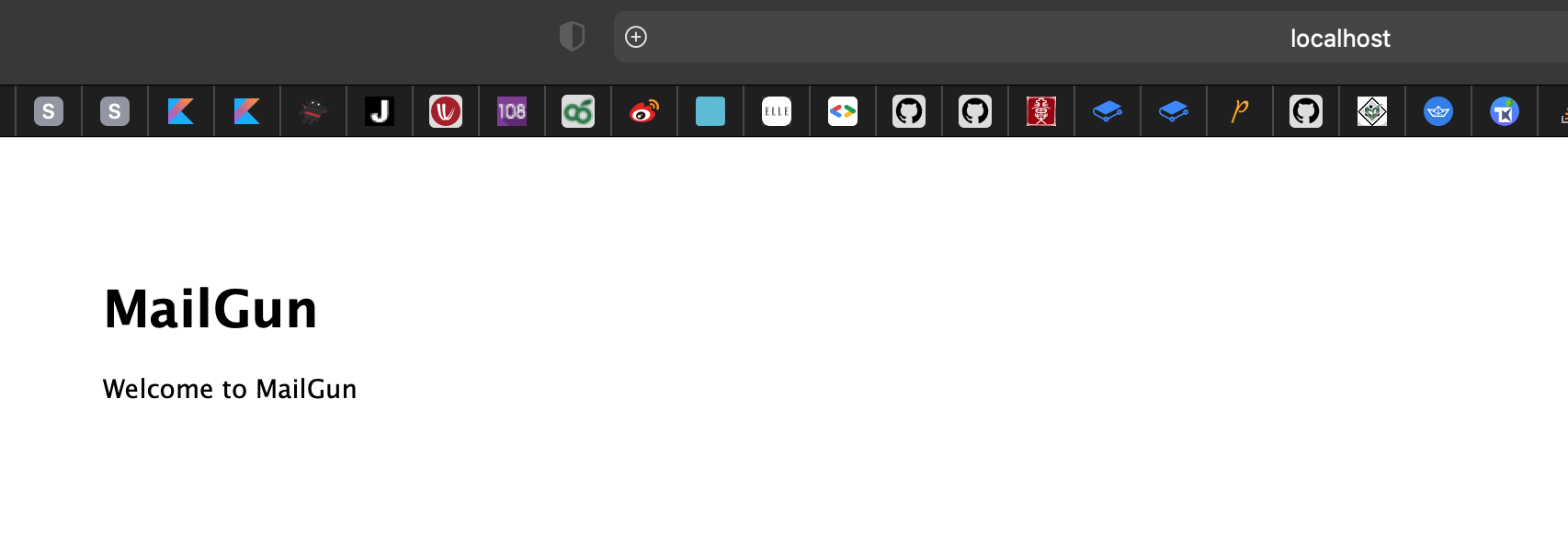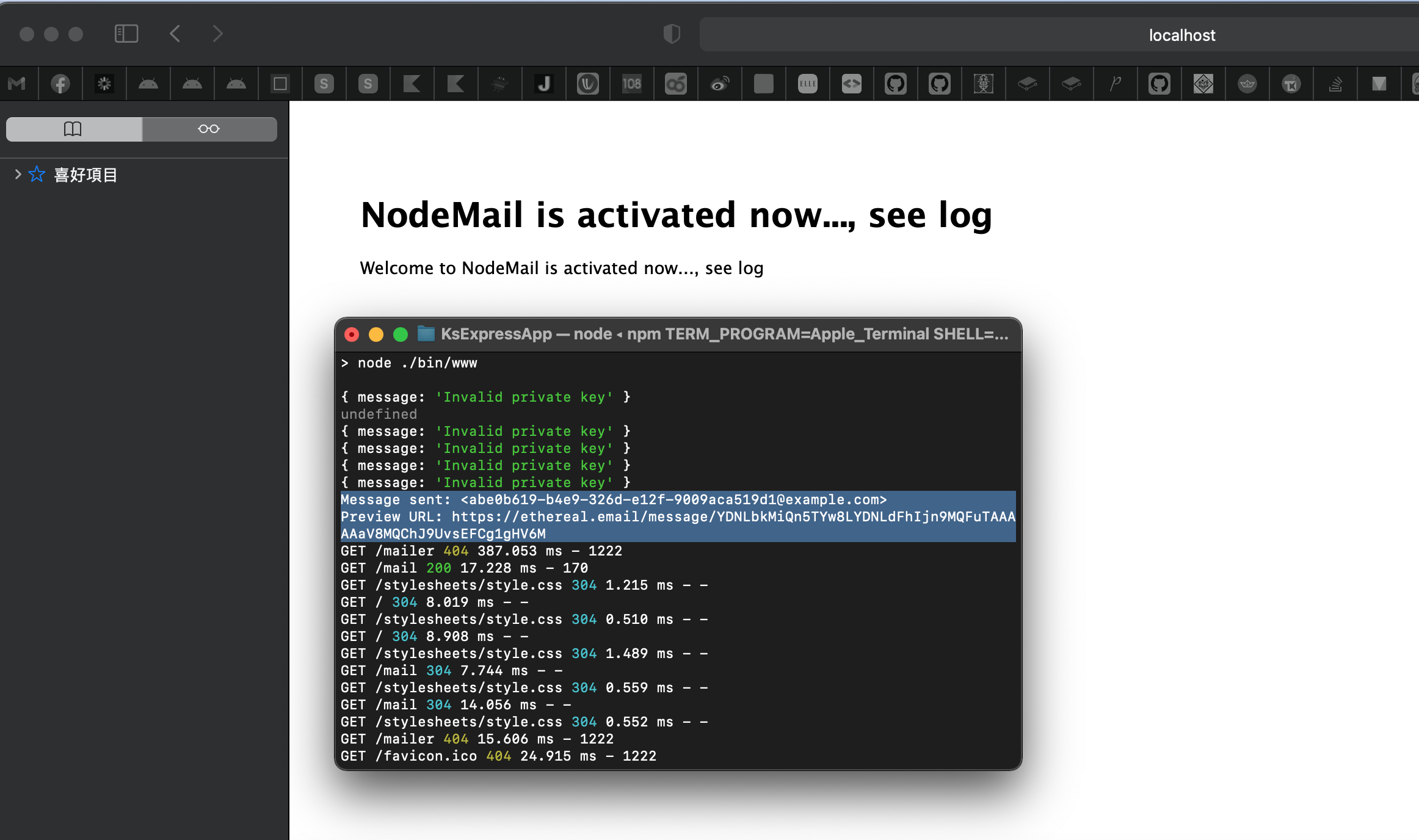MailGun
MailGun
cd to proj_dir, then execute cli as
npm start
then browse to localhost:3000, and route to /mail

and browse to localhost:3000, and route to /nodemail

and route to /gmail
var fs = require('fs');var readline = require('readline');var google = require('googleapis');var googleAuth = require('google-auth-library');var express = require('express');var router = express.Router();router.get('/', function(req, res, next) {res.render('gmail', { title: 'GMail is abled now..., see log' });});var SCOPES = ['https://mail.google.com/'];var TOKEN_PATH = 'gmail-api-token.json'; // need token// https://console.developers.google.com/apis/dashboard// Load client secrets from a local file.fs.readFile('client_secret.json', function processClientSecrets(err, content) {if (err) {console.log('Error loading client secret file: ' + err);return;}// Authorize a client with the loaded credentials, then call the// Gmail API.authorize(JSON.parse(content), sendMessage);});/*** Create an OAuth2 client with the given credentials, and then execute the* given callback function.** param {Object} credentials The authorization client credentials.* param {function} callback The callback to call with the authorized client.*/function authorize(credentials, callback) {var clientSecret = credentials.installed.client_secret;var clientId = credentials.installed.client_id;var redirectUrl = credentials.installed.redirect_uris[0];var auth = new googleAuth();var oauth2Client = new auth.OAuth2(clientId, clientSecret, redirectUrl);// Check if we have previously stored a token.fs.readFile(TOKEN_PATH, function (err, token) {if (err) {getNewToken(oauth2Client, callback);} else {oauth2Client.credentials = JSON.parse(token);callback(oauth2Client);}});}/*** Get and store new token after prompting for user authorization, and then* execute the given callback with the authorized OAuth2 client.** //param {google.auth.OAuth2} oauth2Client The OAuth2 client to get token for.* //param {getEventsCallback} callback The callback to call with the authorized* client.*/function getNewToken(oauth2Client, callback) {var authUrl = oauth2Client.generateAuthUrl({access_type: 'offline',scope: SCOPES});console.log('Authorize this app by visiting this url: ', authUrl);var rl = readline.createInterface({input: process.stdin,output: process.stdout});rl.question('Enter the code from that page here: ', function (code) {rl.close();oauth2Client.getToken(code, function (err, token) {if (err) {console.log('Error while trying to retrieve access token', err);return;}oauth2Client.credentials = token;storeToken(token);callback(oauth2Client);});});}/*** Store token to disk be used in later program executions.** //param {Object} token The token to store to disk.*/function storeToken(token) {fs.writeFile(TOKEN_PATH, JSON.stringify(token));console.log('Token stored to ' + TOKEN_PATH);}/*** Lists the labels in the user's account.** @param {google.auth.OAuth2} auth An authorized OAuth2 client.*/function listLabels(auth) {var gmail = google.gmail('v1');gmail.users.labels.list({auth: auth,userId: 'me',}, function (err, response) {if (err) {console.log('The API returned an error: ' + err);return;}var labels = response.labels;if (labels.length == 0) {console.log('No labels found.');} else {console.log('Labels:');for (var i = 0; i < labels.length; i++) {var label = labels[i];console.log('- %s', label.name);}}});}/*** Send Message.*/function sendMessage(auth) {var gmail = google.gmail('v1');var email_lines = [];email_lines.push("From: katesapp2019@gmail.com");email_lines.push("To:katesreact2020@gmail.com");email_lines.push('Content-type: text/html;charset=utf-8');email_lines.push('MIME-Version: 1.0');email_lines.push("Subject: Gmail Sender here");email_lines.push("");email_lines.push("text text tex");email_lines.push("<b>bold text text </b>");var email = email_lines.join("\r\n").trim();var base64EncodedEmail = new Buffer(email).toString('base64').replace(/\+/g, '-').replace(/\//g, '_');console.log(base64EncodedEmail);function sendDone(err, response) {if (err) {console.log('The API returned an error: ' + err);return;}console.log('send mail success', response);}gmail.users.messages.send({auth: auth,userId: 'me',resource: {raw: base64EncodedEmail}}, sendDone);}module.exports = router;
ref:
https://www.npmjs.com/package/mail-notifier (npm module)
https://npm.io/search/keyword:email (maingun)
https://nodemailer.com/about/ (nodemailer)